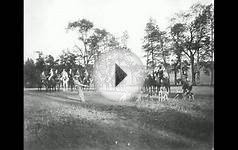 Alexander Deineka (1899–1969). Collective Farm Worker on a Bicycle, 1935. Oil on canvas, 120 x 220 cm. The State Russian Museum, St. Petersburg. © State Russian Museum
Alexander Deineka (1899–1969). Collective Farm Worker on a Bicycle, 1935. Oil on canvas, 120 x 220 cm. The State Russian Museum, St. Petersburg. © State Russian Museum
The Russian Revolution in 1917 ended more than 300 years of tsarist rule. It not only changed life in Russia, but also effectively divided the world into two hostile camps, communist and capitalist, a schism that would dominate much of the history of the 20th century.
Vladimir Lenin, the leader of the Bolshevik Party, formed a new country, the Union of Soviet Socialist Republics (USSR), commonly called the Soviet Union. Under Soviet rule the government controlled everything. All agricultural land was organized into large collective farms, where everyone worked for the state. Employment, food, housing, and education were made available to everyone, but political and civil rights were severely curtailed.
During the first five years of Soviet rule, Russia was plagued by civil war, famine, invasion, and rebellions by nationalities fighting for independence. In 1924, Lenin died, and a struggle for power raged at the highest levels. Starting in 1927, Josef Stalin initiated the first of the Soviet Union’s five-year plans, which focused on harnessing all economic power to the state. Industrialization proceeded swiftly and peasants were brutally collectivized. Artists were next on his list.
In 1932, the Soviet state proclaimed that all artists must embrace the Socialist Realist philosophy and style. Its principles included loyalty to the Communist Party and correct ideological stance and content. Those who did not conform could be interrogated, imprisoned, or even executed.








